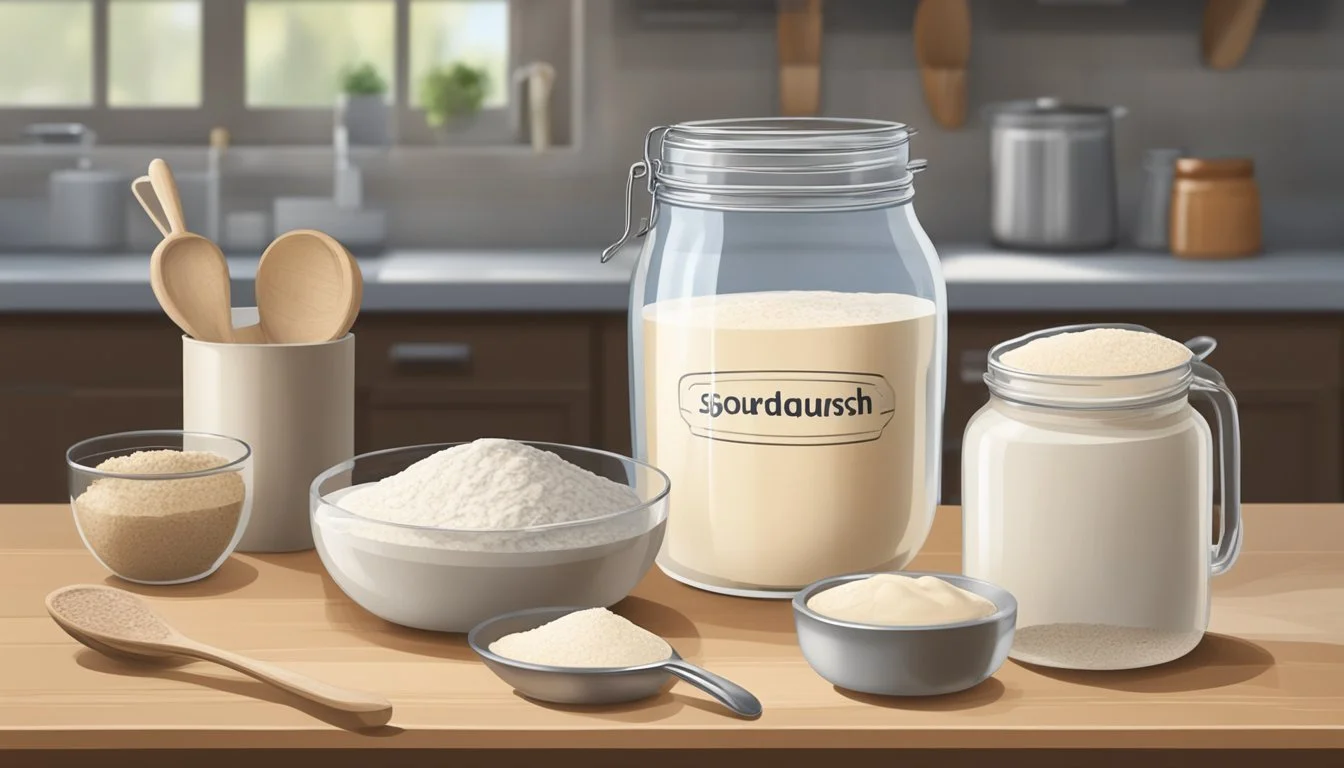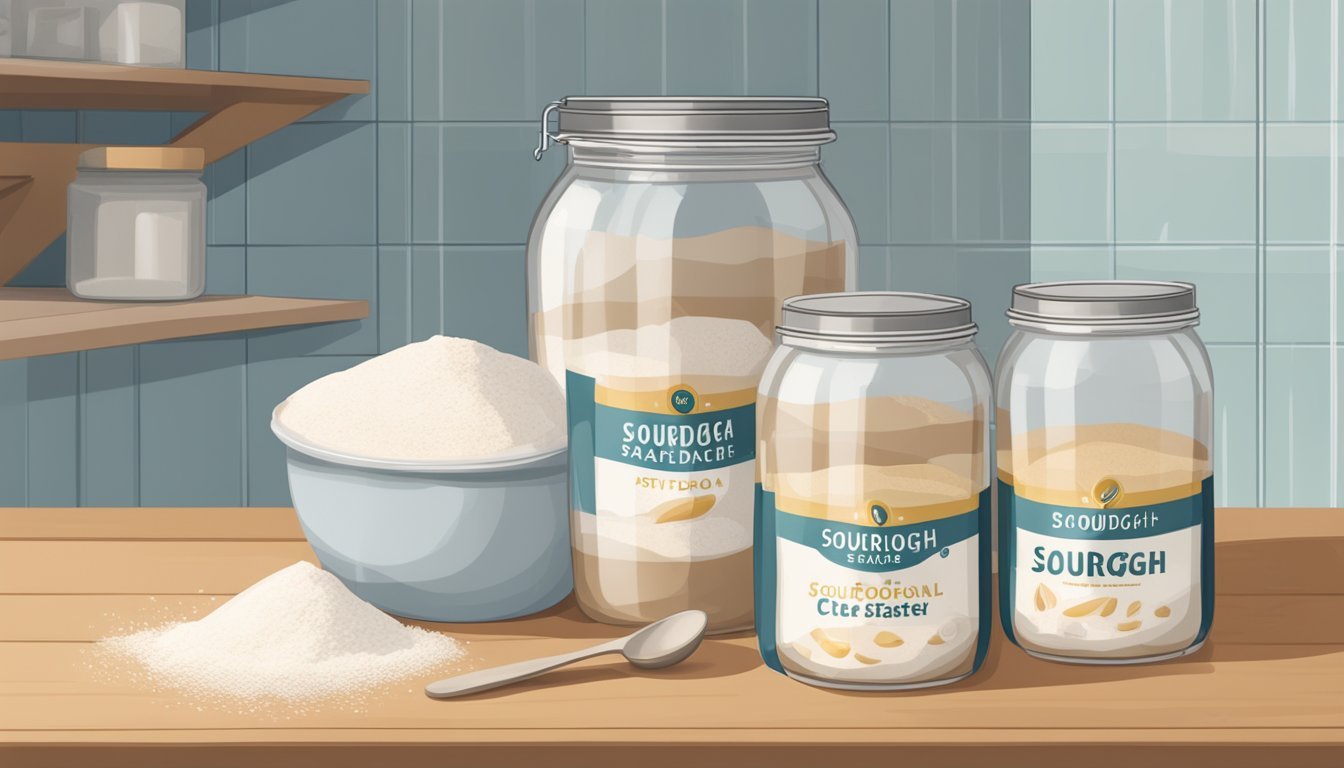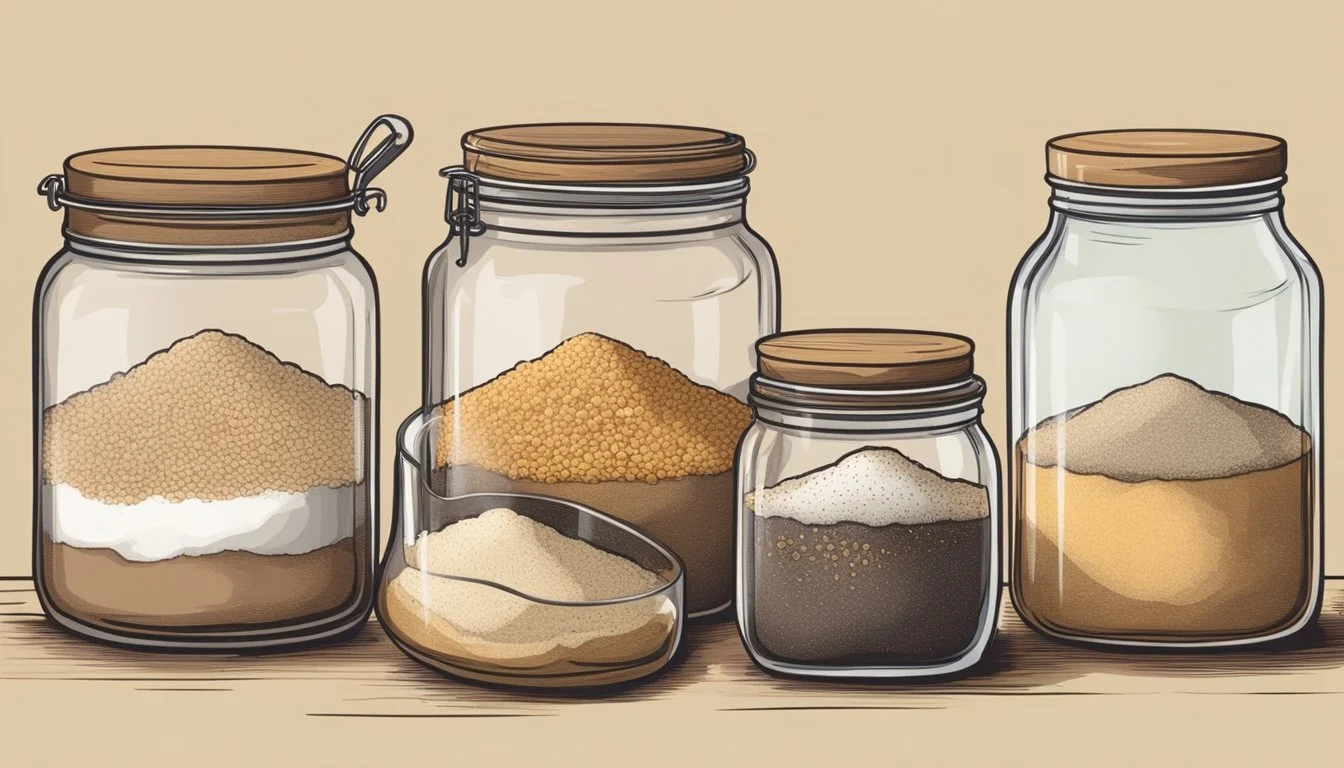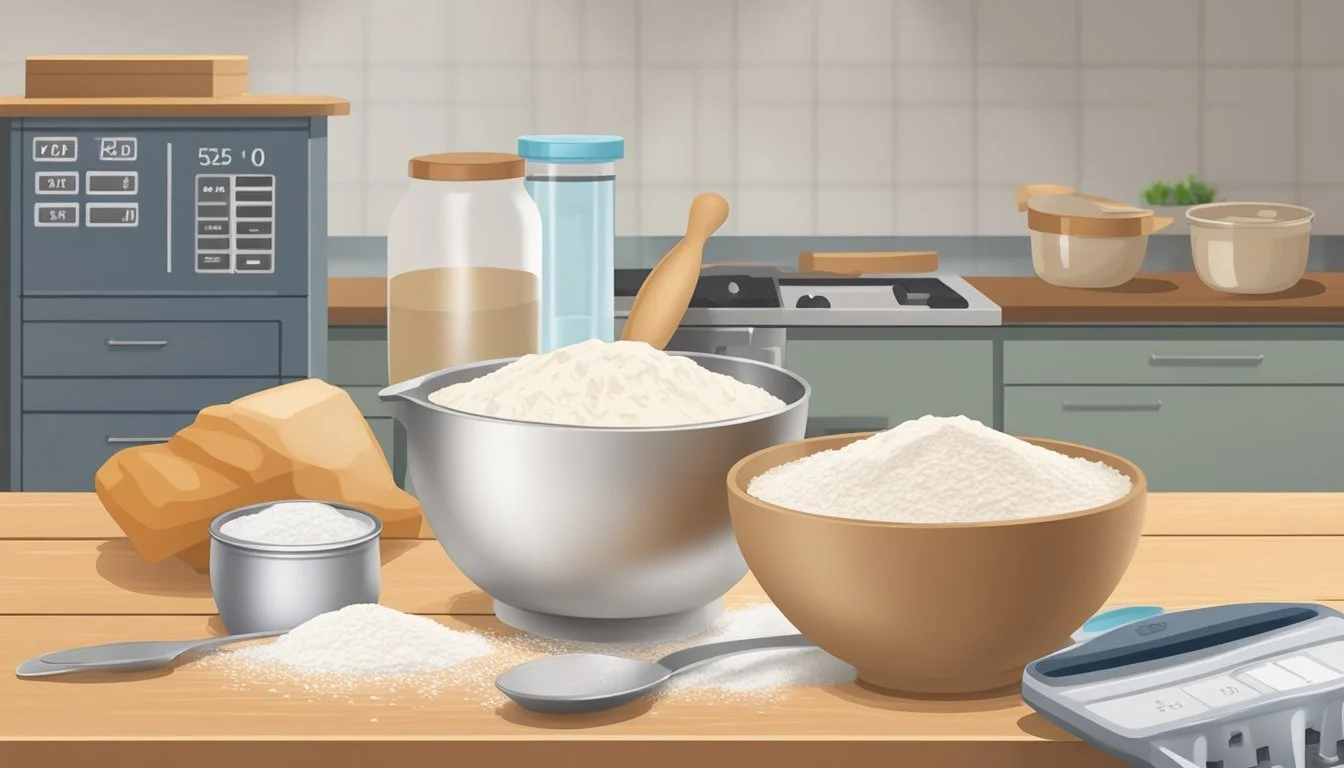Sourdough Starter Substitutes
Alternative Ingredients for Your Bread
Sourdough bread (What wine goes well with bread?), known for its characteristic tangy flavor, chewy texture, and crisp crust, is traditionally made using a sourdough starter. This starter is a fermented mixture of flour and water that contains wild yeast and lactobacilli, which not only causes the bread to rise but also imparts its unique sour taste. However, creating and maintaining a sourdough starter requires time and dedication, as it can take several days to develop the right balance of yeast and bacteria.
For those who wish to bypass the lengthy process of cultivating a starter or for moments when a ready starter isn't at hand, there are alternatives that can substitute for sourdough starter in bread recipes. These substitutes provide the leavening effect needed for the bread to rise and can impart a flavor that, while not identical, carries some of the sour notes associated with sourdough bread. Common substitutes include commercial yeast combined with ingredients like Greek yogurt or vinegar, which can introduce the desired acidity to the dough.
When using yogurt as a substitute, for instance, it is crucial to select plain varieties containing live active cultures to closely mimic the bacterial component of sourdough starter. The live cultures in yogurt can create a similar tangy flavor, while the inclusion of a leavening agent such as commercial yeast ensures the bread will rise. The balance between the tanginess and the ability to rise can lead to satisfactory results, making sourdough-like bread accessible even without a traditional starter.
Understanding Sourdough Starter
In the context of sourdough bread, the starter is integral as it contains the live cultures necessary for fermentation. Its complexity involves a balance of bacteria and wild yeast that impacts flavor, texture, and health.
Components and Function
The sourdough starter consists of two main components:
Flour: Provides carbohydrates which are essential for feeding the bacteria and yeast.
Water: Creates the environment for the starter to become an active site of fermentation.
Functionally, the starter acts as a leavening agent. It essentially ferments the dough through the activities of the wild yeast and beneficial bacteria which produce carbon dioxide gas and alcohol. This gas gets trapped in the gluten structure of the dough, leading to the rise of the sourdough bread.
Sourdough Versus Commercial Yeast
Utilizes wild yeast and bacteria.
Fermentation is typically slower, contributing to more complex flavors.
Can aid in gluten development, which is beneficial for individuals with slight gluten sensitivities, though not suitable for those with celiac disease.
Comprised of isolated strains of Saccharomyces cerevisiae.
Results in a faster and more consistent rise.
Lacks the depth of flavor and the additional health benefits of live cultures found in sourdough.
Fermentation Science
In the fermentation process, the cultures metabolically convert carbohydrates into carbon dioxide gas and organic acids. Two main types of fermentation occur in a sourdough starter:
Alcoholic fermentation by yeasts, yielding carbon dioxide and ethanol.
Lactic acid fermentation by lactic acid bacteria, enhancing flavor and health value.
The balance between these ferments is crucial for achieving optimal fermentation, impacting sourdough bread's taste and texture significantly.
Sourdough Starter Substitutes
When a traditional sourdough starter isn't available, various substitutes can be used to achieve a similar tangy flavor and leavening effect in bread making. These substitutes can be categorized based on their fermentation principles and composition.
Yeast-Based Substitutes
Commercial yeast is often the go-to substitute for sourdough starter. The typical recipe adjustment involves compensating for the hydration level in the dough when replacing the sourdough starter. Here's a simple conversion to follow:
For every 100 grams of 100% hydration sourdough starter:
Add 50 grams of flour
Add 50 grams of water
Incorporate 1 teaspoon of dry yeast
This substitution does not require the long fermentation needed for traditional sourdough, making it a time-efficient alternative.
Natural Leavening Alternatives
Plain yogurt with live active cultures can serve as a natural leavening agent to impart the tangy flavor characteristic of sourdough bread. When using yogurt:
Select plain, unsweetened yogurt to avoid altering the bread's taste.
Use a ratio of yogurt to flour based on the specific recipe, keeping in mind that the moisture content of yogurt should be accounted for.
Other leavening alternatives that can be used overnight to develop flavor include:
Kefir
Vinegar mixed with milk
Pre-ferments like poolish or biga
DIY Sourdough Starter
For bakers with more time, creating a DIY sourdough starter requires just flour and water. To begin the fermentation process:
Mix equal parts flour and water and let the mixture sit in a warm place.
Feed it daily with equal parts water and flour.
After several days to a week, the starter will begin to bubble and develop a tangy scent, signaling it's ready to use.
These methods offer alternative routes to achieving sourdough bread's distinctive taste and texture, accommodating various schedules and ingredient availability.
Recipes and Applications
In exploring the versatility of sourdough starter substitutes, one can find ample opportunities to incorporate them in a variety of recipes, from classic bread and doughs to inventive dishes that surprise the palate.
Breads and Doughs
For those looking to bake sourdough bread without a traditional starter, alternative recipes offer streamlined approaches. One can use instant yeast with the ratio of 1/2 teaspoon to 3 cups of bread flour. It is essential to add salt, typically 1 teaspoon, to the flour before mixing in 1 and 1/2 cups of warm water to form the dough. Optional ingredients like honey, which might be included to enrich the flavor and aid in browning, should be added at this stage. Careful kneading for about 10 minutes and allowing ample rise time will ensure a satisfying texture and crumb.
Instructions:
Combine flour, salt, yeast, and warm water (honey if preferred).
Knead the mixture for approximately 10 minutes.
Leave to rise until the dough doubles in size.
Shape and bake in a dutch oven for a crisp crust.
Pancakes and Crepes
Sourdough starter substitutes like yogurt can instill a desirable tanginess in pancakes and crepes, enhancing their taste and texture. Plain yogurt with live active cultures serves as an excellent addition, creating a tender and flavorful batter.
Pancake Recipe:
1 cup flour
1 tablespoon sugar
1 teaspoon baking powder
1/4 teaspoon salt
1 cup plain yogurt
1/4 cup water
Simply mix the dry ingredients, blend in the yogurt and water, and cook on a hot griddle.
Unique Applications
Beyond bread and breakfast items, sourdough starter substitutes may also be used in less traditional recipes. For instance, they can be integrated into waffle batter or used to create a tangy pizza crust. Experimentation is encouraged, as the substitute's impact on taste and texture can lead to pleasantly unique culinary experiences.
Example: Tangy Pizza Crust
2 cups flour
1 teaspoon salt
1/2 teaspoon instant yeast
1 cup yogurt with live cultures
1 tablespoon olive oil
Water as needed for consistency
Blend until the mixture reaches a pliable consistency, allow it to rise, and then form your pizza base for a novel twist on a classic dish. Bake as usual and enjoy the enhanced flavor profile.
Practical Tips and Tricks
In the quest to perfect the art of sourdough bread, one must master the nuances of starter substitutes. It’s essential for bakers to understand the intricacies of hydration and consistency, flavor infusion and adaptation, as well as proper measurement and scaling.
Hydration and Consistency
Hydration refers to the water content in a sourdough starter and is crucial for achieving the desired consistency of the dough. A 1:1:1 feeding ratio by weight — equal parts starter, flour, and water — is a commonly recommended baseline for maintaining an active starter. For a stiffer dough, reduce the water; for a more fluid dough, increase it.
Example for a 1:1:1 feeding ratio:
50 grams starter
50 grams flour
50 grams water
Adjustments can be made depending on ambient temperature and desired dough characteristics.
Flavor Infusion and Adaptation
Bakers can infuse complex flavors into their sourdough bread by experimenting with different types of flours and hydration levels. For a richer flavor, incorporating whole grain flours like rye or spelt can introduce new flavor dimensions. Discards from regular feedings can be utilized in other recipes, offering a unique taste and reducing waste.
Flavor development with different flours:
White flour: Neutral base, good for beginners.
Whole rye flour: Intense flavor, good for a more robust taste.
Combination: Mix different flours to create personalized flavor profiles.
Proper Measurement and Scaling
Accuracy in measurement is critical to consistently reproduce high-quality sourdough bread at home. Bakers should always use grams for exact scaling and predictable results. A kitchen scale is a vital tool, ensuring precise ratios which are fundamental for the starter's health and the bread's texture.
Essential measurements for starter feedings:
Starter: the base for fermentation, usually measured in grams.
Flour: the food for the starter, important to match the weight of the starter.
Water: activates the flour and starter mixture, should equal the weight of the flour.
By observing these practical tips and tricks, bakers can ensure their sourdough starter is well-hydrated, infused with delightful flavors, and accurately measured for creating delicious homemade sourdough bread.
Health Considerations
When discussing the health considerations of using sourdough starter substitutes, one must examine both digestibility aspects and the nutritional benefits offered by traditional sourdough bread.
Digestibility and Glycemic Index
Artisanal sourdough bread is notable for its improved digestibility. Its fermentation process breaks down gluten to a greater extent than in breads made with commercial yeast, which can make it easier to digest for some individuals. Furthermore, sourdough often exhibits a lower glycemic index (GI), which means it raises blood sugar levels more slowly, an advantage for managing insulin responses and promoting satiety.
Nutritional Benefits of Sourdough
Sourdough fermentation has a positive influence on the nutritional profile of bread. Research indicates that sourdough bread may offer health benefits by enhancing the availability of minerals like calcium, sodium, zinc, and magnesium due to the action of natural acids produced during fermentation. These acids can reduce mineral-binding phytates, making these nutrients more accessible to the body.
Advanced Techniques
In sourdough baking, achieving the right flavor and texture often requires precise control over the fermentation process and a willingness to experiment with various factors that contribute to depth and complexity.
Creating Depth and Complexity of Flavor
Bakers seeking to enhance the flavor of sourdough bread can engage in a few advanced techniques. One method includes adjusting the ratio of flours, where a combination of whole grain to white flour can infuse the bread with a range of subtle flavors.
Incorporate Unique Flours: Utilizing a blend of rye or spelt flour can add a distinct taste to the bread.
Proper Hydration: Adjusting water content is essential. Higher hydration can lead to a more open crumb and complex flavor profile.
The use of additives like malt powder or an infusion of herbs can give a unique twist, while sweeteners like honey or sugar can not only increase the browning of the crust but also add a subtle flavor note.
Manipulating Fermentation Times
The fermentation process is crucial for developing flavor and affecting the bread's rise. Bakers have two significant rises to manipulate: the first rise, also known as bulk fermentation, and the second rise after shaping.
First Rise (Bulk Fermentation):
Lengthening this phase can lead to more complex flavors but increases the risk of over-proofing.
The temperature at which the first rise occurs greatly affects flavor development—cooler temperatures result in a slower fermentation, allowing for a deeper taste to develop.
Second Rise:
Shorten to give the final product a milder flavor, or lengthen for a more pronounced sourness.
This rise largely determines the final texture and should be monitored closely for timing.
Fine-tuning the duration and conditions during each rise can dramatically alter the sourdough's character. Bakers may experiment with retarding the dough (slowing down the fermentation) by refrigerating it during the first or second rise, which can enhance the sourdough's flavor complexity.
Note: It's important to remember that these techniques require observation and adaptation since the dough's responsiveness can vary with environmental factors and ingredient quality.
Troubleshooting and Solving Common Issues
In crafting the perfect sourdough bread, bakers may encounter various issues affecting leavening, texture, and flavor. This section presents practical ways to diagnose and solve these problems.
Leavening and Rising Challenges
Leavening issues often stem from the starter's activity. If the rise is insufficient, it may be due to low temperature. The optimum temperature for a starter is around 75°F to 85°F. Maintaining this range accelerates fermentation, enhancing the leavening action. Ensure consistent feeding schedules and retain a hydration level conducive to the starter's activity—commonly between 100-125% for balance between speed and manageability.
Temperature: Keep the starter warm to increase activity.
Feeding: Regular feedings ensure yeast vitality.
Hydration: Adjust hydration for optimal fermentation.
Texture and Crumb Quality
The texture and crumb quality of sourdough can be indicative of the starter's health. A dense crumb may be due to low hydration levels, so one should aim for a hydration ratio suited to their desired texture. Too low, and the dough will be stiff; too high, and it may create a batter-like consistency. For a more chewy texture, increase hydration slightly, but maintain control for a manageable dough.
Hydration Adjustment: Balance hydration for a workable mixture.
Starter Consistency: Aim for a thick, yet fluid starter consistency.
Flavor Problems
Flavor problems typically relate to fermentation by-products. An overly sour flavor suggests prolonged fermentation or excessive accumulation of by-products like hooch. To mitigate this, one may:
Feeding Frequency: Increase to reduce sourness.
Starter Maintenance: Stir hooch back in or pour off if excessive sourness is noted.
The sour flavor of sourdough is indeed a desired characteristic, but balance is key. Adjusting the feeding ratio of flour to water can subtly influence the outcome, fostering a more palatable sour profile without overwhelming the senses.
Maintenance and Storage
Proper maintenance and storage are vital for the health and longevity of a sourdough starter. They ensure the starter's reliability and fermenting power, critical for traditional sourdough baking.
Feeding and Refreshing Routines
A sourdough starter requires regular feeding and refreshing to maintain its vitality. The feeding process typically involves discarding a portion of the starter and adding fresh flour and water. For starters kept at room temperature:
Frequency: Feed once daily.
Ratio: Combine 1 part starter with 1 part water and a slightly equal part (by weight) of flour.
For instance:
Starter Water Flour 50g 50g 50g
Starters stored in the fridge can be fed less frequently:
Frequency: Feed once weekly.
Ratio: Use the room temperature feeding ratio.
Feeding creates a fresh, active pre-ferment, essential for a robust sourdough.
Preserving for Future Use
To preserve a sourdough starter for future baking sessions:
Short-term storage: Keep in the fridge with a tight lid, feeding once a week.
Long-term storage: A dried sourdough starter can last months. Spread thin on a baking sheet, allow it to dry completely, then break into flakes and store in an airtight container.
One can reactivate the starter by rehydrating with water and resuming regular feedings.
Storage in the fridge is a common practice that slows down fermentation, offering flexibility for bakers and ensuring the starter's resilience.
Transitioning to Sourdough Baking
Transitioning from baking with commercial leavening agents to using sourdough starter introduces complex flavors and requires a grasp of fermentation science. It is a rewarding process that benefits from a foundational understanding of dough development and patience.
From Quick Breads to Sourdoughs
Quick breads rely on ingredients like baking soda and baking powder for leavening, which react chemically to create carbon dioxide bubbles when mixed with moisture. This process is fast and beginner-friendly, often requiring nothing more than combining ingredients and baking immediately. In contrast, sourdough baking involves a more complex biological process where a mixture of flour and water, known as sourdough starter, naturally ferments.
When one transitions from quick breads to sourdoughs, they must adjust to the longer fermentation times required. A sourdough starter contains a culture of wild yeast and lactic acid bacteria. This culture ferments the dough, which can take several hours and sometimes days, a marked difference from the nearly instantaneous results achieved with baking powder or soda.
Incorporating Sourdough into Daily Baking
To incorporate sourdough into daily baking, one must plan for longer preparation times. Here's a basic outline of what to expect:
Preparation: The night before baking, one needs to feed their sourdough starter to ensure it is active and ready for use.
Mixing: Replace commercial yeast with sourdough starter in the recipe. A common ratio is using 15-20% of the flour weight in starter.
Fermentation: The dough might need to rise for several hours or be placed in a refrigerator for a slow fermentation that can last overnight.
Shaping and Proofing: Once the dough has risen, shape as desired. It will require a final proof, which can also be extended for enhanced flavor.
Throughout this process, the acidity from the sourdough starter improves the bread's flavor and texture, contributing to its distinctive sour taste. The baker must be mindful of the hydration levels in their dough, as the sourdough starter contributes both flour and water content.
By understanding these key differences and planning, bakers can successfully make the change from quick breads to sourdoughs.
Cultural and Historical Perspective
Sourdough has transcended its origins as a staple bread-making technique, reflecting a rich tapestry of cultural significance and modern relevance. It embodies the art of traditional baking, where wild bacteria play a crucial role.
Sourdough in Different Cultures
Sourdough bread is not the invention of a single culture; rather, it is a testament to the ingenuity of many. Its earliest roots can be traced to ancient Egypt, where it is believed the art of fermented dough began. Throughout history, each culture infused its unique twist into sourdough, passing it down through generations as a living piece of heritage.
Europe: The French are known for their iconic baguettes and crusty boules, with sourdough starter contributing significantly to the distinct taste and texture.
Middle East: Traditional flatbreads like Pita often employed natural fermentation processes similar to those in sourdough.
San Francisco, USA: A specific wild bacteria found in their local starter gave rise to the famous San Francisco sourdough, a bread with a unique tang and a hearty crust.
The Relevance of Sourdough Today
The practice of creating and maintaining a sourdough starter is seen as both a ritual and a science. In recent times, the global pandemic saw a resurgence in sourdough bread-making at home, with many seeking to reconnect with traditional food art and planning their baking days around starter fermentation cycles. Sourdough today is not just a culinary trend but an emblem of resilience and a link to a more self-sufficient lifestyle.
For many, the process of nurturing a starter is akin to caring for a living entity, since a well-maintained culture can last indefinitely, producing loaf after loaf of wholesome bread. This ongoing tradition maintains the ancient methods while enforcing the importance of sustainable, mindful baking practices.
Conversions and Calculations
In substituting sourdough starter in recipes, precision is key. The reader needs to understand that converting recipes for sourdough requires adjustments in flour and water quantities to maintain the correct hydration and proofing time.
Recipe Conversion
When converting a yeast recipe to use sourdough starter, one must account for the hydration of the starter. A common baseline is that 100 grams of sourdough starter can replace a typical 7-gram packet of yeast. To keep the recipe balanced, they should reduce the amount of all-purpose flour and warm water by 50 grams each for every 100 grams of starter used. This adheres to the typical sourdough starter hydration level of 100%, which is equal parts water and flour by weight.
For example, when using 200 grams of sourdough starter:
Reduce flour: Original flour amount minus 100g (from the starter)
Reduce water: Original water amount minus 100g (from the starter)
This ensures the dough maintains its intended texture and the starter's comparable tangy flavor and aroma are effectively incorporated.
Adjusting for Altitude and Climate
Altitude and climate have significant impacts on sourdough baking. Higher altitudes often require increased hydration, as lower air pressure can cause quicker evaporation of water in dough. Conversely, a humid climate may necessitate less water to prevent overly sticky dough.
Adjustments for high-altitude baking could include:
Increase water: add 1-2 tablespoons of water per cup of flour
Shorten proofing time: yeast and sourdough starters ferment faster at higher altitudes
It is recommended that bakers in different climates start with small adjustments and keep detailed notes. This way, they can link specific changes to outcomes and consistently achieve a desirable sourdough texture and flavor.







